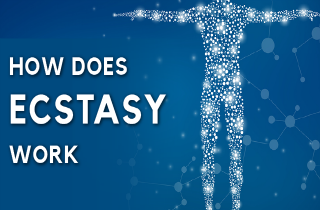Here, we review the basic chemical interactions of how ecstasy works in your body. We introduce brain and the nervous system effects, review half-life and peak levels, and sum up with differences among ecstasy users. Save your questions about MDMA and treating ecstasy addiction for the end – we invite you to post them in the comments section below.
What is ecstasy?
Ecstasy is a Schedule I controlled substance, available primarily in tablet forms of various colors. Ecstasy is recreationally used as a party, rave or dance drug for its stimulant and mild hallucinogenic properties. Tablets sold as ecstasy usually contain 3,4-methylenedioxy-N-methylamphetamine (MDMA), but may also be mixed with caffeine, ephedrine, dextromethorphan, amphetamine, methamphetamine and ketamine. Some tablets have even been reported to contain LSD or heroin.
Ecstasy is taken through oral, sublingual, insufflation, inhalation, injection, and rectal administration. MDMA can induce euphoria, a sense of intimacy with others, diminished anxiety, and mild psychedelic effects. But how and why does ecstasy produce these effects in the body?
How does ecstasy work in the body?
MDMA is a phenylethylamine that triggers stimulant and psychedelic effects first in the brain, and then in the body. MDMA does not act by directly releasing serotonin but, rather, by binding to, and thus blocking, the transporter involved in its reuptake. Typical effects of ecstasy in the body include:
- ataxia (loss of control of body movements)
- dilated pupils
- dry mouth
- involuntary jaw clenching
- mild visual disturbances (blurred or double vision, increased light sensitivity)
- muscle tension
- sweating
How does ecstasy affect the brain and nervous system?
MDMA works by increasing levels of the neurotransmitters norepinephrine and dopamine in the central nervous system. At the same time, MDMA destroys serotonin-producing neurons which play a direct role in regulating aggression, mood, sexual activity, sleep, and sensitivity to pain. While many users think that MDMA is not addictive, this is not true. While physical dependence on ecstasy is rare, psychological dependence is possible. And needing help with ecstasy addiction can be avoided by avoiding large or chronic dosing of MDMA.
Repeated or large doses of ecstasy may cause permanent harm and impairment. Ecstasy is also well known for its potential neurotoxicity (ability to damage neurons.) If neurotoxicity occurs, then the slow reversal of neuroadaptation isn’t enough to fully restore the brain to its pre-use state. While related in structure and effect to methamphetamine, MDMA has significantly less central nervous system (CNS) stimulant properties than methamphetamine.
How fast or quickly does ecstasy work?
Ecstasy is rapidly absorbed into the body. Following oral administration, effects onset in 20-30 minutes.
MDMA has a half-life of seven (7) hours. During this time, ecstasy is metabolized to a metabolite called MDA which is found in blood and plasma, as are its derivatives HMA and HHA. These polar metabolites are conjugated prior to urine excretion. Peak concentrations of ecstasy are observed at 1.5-2 hours and at 4 hours after ingestion, levels of MDA peak.
How long does ecstasy work?
Desired effects of ecstasy may last only an hour or more, depending on dose. Other general effects last for approximately 2-3 hours. However, no clear correlation exists between MDMA blood concentrations and effects. MDMA and MDA are the analytes detected in blood, Higher MDA:MDMA ratios may indicate co-administration of MDA. LSD is sometimes used in combination with MDMA to increase its duration of effects. Unwanted effects are generally gone within 24 hours although confusion, depression and anxiety may last several weeks. Given enough time, the brain’s sensitivities return to normal, event taking about 3-4 weeks after a single moderate dose.
Does ecstasy work for everyone?
MDMA affects each person in individual ways. Tolerance to ecstasy develops after chronic use and can lead to increased dosage. And researchers have been exploring whether gender plays a role in effects on ecstasy users. However, emergency room statistics do not support this theory. Additionally, while ecstasy (MDMA) was used in the mid 20th century as a possible adjunct to psychotherapy, there is currently no legitimate medical use for ecstasy in the U.S.
How does ecstasy work questions?
Do you still have questions about how ecstasy works in the body? The team at Addiction Blog would be glad to answer your questions. Please post them in the comments section below. We aim to provide you with a personal and prompt answer.









Related Posts